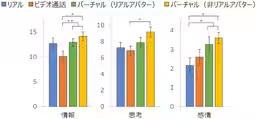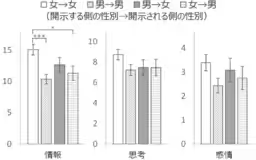

The Impact of Self-Disclosure in Virtual Environments Exceeding the Real World
Exploring the Boundaries of Self-Disclosure in Virtual Environments
In recent years, the rise of online communication platforms has reshaped how we interact, especially through video calls and virtual reality (VR). A research study led by a team from Waseda University investigated the dynamics of self-disclosure across various communication media, including in-person meetings, video calls, and two forms of virtual interactions: one with realistic avatars and the other with non-realistic avatars. This comprehensive analysis aims to shed light on how these environments facilitate or hinder the sharing of personal information between individuals.
Key Findings of the Research
The research aimed to quantitatively measure self-disclosure levels across four distinct media types: in-person communication, video calls, and the two types of virtual environments. Through a series of experiments involving 72 pairs of participants—144 individuals in total—each pair engaged in conversations about personal topics, such as troublesome memories, utilizing one of the identified communication media.
Increased Self-Disclosure in Virtual Contexts
The findings supported the hypothesis that self-disclosure is influenced significantly by the communication medium. Notably, self-disclosure was statistically more pronounced in virtual settings (especially with non-real avatars) than in face-to-face interactions. Interestingly, the difference in self-disclosure levels between video calls and real-life interactions was minimal, suggesting that traditional video platforms maintain a level of personal rapport akin to in-person meetings.
Gender Dynamics Affecting Interaction
The study also explored how the gender composition of the participants influenced self-disclosure rates. The highest levels of self-disclosure occurred among pairs of women, followed by mixed-gender pairs and male pairs. This indicates that gender dynamics continue to play a crucial role in how freely individuals share personal information, regardless of the medium used.
The Importance of Self-Disclosure in Building Relationships
Understanding how self-disclosure varies between online and real-world interactions is critical for the continued development of communication tools and techniques that foster relationship-building. As online communication becomes more integral in educational and professional contexts, insights from this research can help enhance platforms aimed at improving interpersonal connections.
Methodology
Participants were evaluated across multiple dimensions of self-disclosure, including verbal cues, non-verbal behaviors, physiological responses, and subjective assessments via surveys. Researchers captured the nuances of each communication medium, especially focusing on how effectively participants perceived their self-disclosure during interactions. The results indicated a substantial variance in emotional disclosure, highlighting that individuals may feel more liberated to share sensitive feelings in virtual settings without the direct pressure of face-to-face engagement.
Implications for Future Applications
The implications of enhanced self-disclosure in virtual realms extend beyond mere interpersonal connections; they encompass therapeutic settings and support systems. With evidence pointing to the effectiveness of virtual platforms in promoting emotional expression, various applications could emerge in mental health services, including therapy and counseling sessions held in virtual environments.
Potential applications could include:
- - Counseling services for individuals facing mental health challenges, such as depression or anxiety, where clients engage in therapeutic interactions with professionals in a virtual space.
- - Support networks facilitating peer-to-peer conversations, reducing isolation among individuals suffering from chronic health conditions.
- - Stress-relief services powered by AI agents, allowing users to voice their concerns candidly and receive feedback without judgment.
Challenges and Future Directions
This study's limitations include a narrow focus on specific avatar gender presentations and the dynamics of interactions among individuals who are not well-acquainted. Future studies must consider the impact of varied avatar representations and explore self-disclosure in familiar relationships, which may yield distinct behaviors and responses. By delving deeper into these areas, researchers can further understand the implications of virtual environments as social communication tools.
Conclusion
As the integration of virtual and augmented realities into everyday communication becomes more pronounced, understanding the dynamics of self-disclosure in these contexts is critical. The research opens doors to broader considerations on how society can effectively utilize virtual environments for emotional and relational growth, paving the way for innovative communication practices that thrive on the rich potential of human interaction, even in virtual spaces.









Topics People & Culture)










【About Using Articles】
You can freely use the title and article content by linking to the page where the article is posted.
※ Images cannot be used.
【About Links】
Links are free to use.